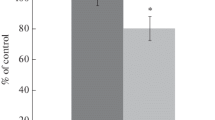Summary
Neuronal cell damage following ischaemia is postulated to be due to free radical induced lipid peroxidation, and ascorbic acid is supposedly an important non-enzymatic scavenger of such free radicals. This study was undertaken to evaluate the protective effect of ascorbic acid on the brain in a primate model after focal cerebral ischaemia. Consumption of ascorbic acid in the monkey brain following ischaemia and its effect on macroscopic infarct size as demonstrated by 2, 3, 5, Triphenyl tetrazolium chloride (TTC) staining were used as parameters.
The monkeys in the treated group were given 1 gram ascorbic acid parenterally every day for six days. The mean level of total ascorbic acid in right basal ganglia was 35.1±4.2 μg/mg of protein in the treated group as opposed to 22.9±2.1 μg/mg of protein in the nontreated group both before ischaemia. After right middle cerebral artery occlusion to produce focal cerebral ischaemia, the total ascorbic acid in the right basal ganglia 2 hours post ischaemia was 13.3±3.1 μg/mg of protein in the treated group as opposed to 9±1.6 μg/mg of protein in the untreated group. The average consumption of total ascorbic acid was 21.8 μg/mg of protein in the treated group and 13.9 μg/mg of protein in the nontreated group.
Macroscopic infarct size as determined by TTC staining in the right cerebral hemisphere was 11.7±6.9 in treated group whereas it was 24.4±4.4 (expressed as percentage of right hemisphere) in the non-treated group. There was significant reduction in the size of the infarct in the treated group.
A short course of mega-dose Ascorbic acid therapy was found to significantly decrease the macroscopic infarct size. Pretreatment with ascorbic acid enhanced its storage and utilization during ischaemia resulting in its protective effect.
Similar content being viewed by others
References
Bederson JB, Pitts LH, Germana SM,et al (1986) Evaluation of 2, 3, 5, triphenyl tetrazolium chloride as a stain for detection and quantification of experimental cerebral infarction in rats. Stroke 17: 1304–1308
Bose B, Jones SC, Long R,et al (1988) Evolving focal cerebral ischaemia in cats: spatial correlation of nuclear magnetic resonance imaging, cerebral blood flow. Tetrazolium staining and histopathology. Stroke 19: 28–37
Demopoulos HB (1980) The free radical pathology and the microcirculation in the major CNS disorders. Acta Physiol Scand [Suppl] 492: 91–119
Doba T, Burton GW, Ingold KU (1985) Antioxidant and coantioxidant activity of Vit C. Biochim Biophys Acta 835: 298–303
Flamm ES, Demopoulos HB, Seligman ML, Poser RG (1978) Free radicals in cerebral ischaemia. Stroke 9: 445–447
Frei B, England L, Ames BN (1989) Ascorbate is an outstanding antioxidant in human blood plasma. Proc Natl Acad Sci 86: 6377–6381
Fridovich I (1978) The biology of oxygen radicals. Science: 201: 875–880
Hayakawa T, Waltz AG, Jacobson RL (1979) Hypertension and acute focal cerebral ischaemia. Infarction and oedema after occlusion of middle cerebral artery in cats. Stroke 10: 263–267
Kinuta Y, Kikuchi H, Ishikawa M, Kimura M, Itokawa Y (1989) Lipid peroxidation in focal cerebral ischaemia. J Neurosurg 71: 421–429
Klein HH, Pich S, Lindert S,et al (1989) Combined treatment with Vit E and Vit C in experimental myocardial infarction in pigs. Am Heart J 118: 667–673
Lowry OH, Rosebrough NJ, Farr Al, Randall RJ (1951) Protein measurement with the folin-phenol reagent. J Biol Chem 193: 265–275
Nagarajan S, Theodore DR, Abraham J, Balasubramanian AS (1988) Free fatty acids, lipid peroxidation and lysosomal enzymes in experimental focal cerebral ischaemia in primates. Loss of lysosomal latency by lipid peroxidation. Neurochem Res 13: 193–201
Osborne KA, Shigeno T, Balarsky IM,et al (1987) Quantitative assesment of early brain damage in a rat model of focal cerebral ischaemia. J Neurol Neurosurg Psychiatry 50: 402–410
Schwartz MA, Williams JN Jr (1955) New procedure for ascorbic acid analysis by the osazone method. Proc Soc Exp Biol Med 88: 137–139
Siesjo BK (1981) Cell damage in the brain. A speculative synthesis. J Cereb Blood Flow Metab 1: 155–184
Yoshida S, Busto R, Watson BD, Santiso M, Ginsberg MD (1985) Postischaemic cerebral lipid peroxidation in vitro: modification by dietary Vit E. J Neurochem 44: 1593–1601
Fuzimoto S, Mizoi K, Yoshimoto T, Suzuki J (1984) Protective effect of Vit E on cerebral ischaemia. Surg Neurol 22: 449–454
Theodore D, Abraham J (1980) A sequential study of capillaries in the infarcted area of primate brain. Indian J Med Res 71: 821–828
Wayner DD, Burton GW, Ingold KU (1986) The antioxidant efficiency of Vit C is concentration dependent. Biochim Biophys Acta 884: 119–123
Author information
Authors and Affiliations
Rights and permissions
About this article
Cite this article
Ranjan, A., Theodore, D., Haran, R.P. et al. Ascorbic acid and focal cerebral ischaemia in a primate model. Acta neurochir 123, 87–91 (1993). https://doi.org/10.1007/BF01476291
Issue Date:
DOI: https://doi.org/10.1007/BF01476291




